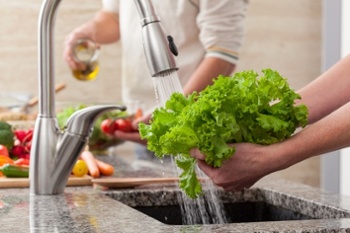 When there is notice of an outbreak or a recall related to produce, we can all agree that it is not something that we want to be associated with, whether it was caused from produce sent out by our operation or whether it is produce that we have consumed. With buyer specifications and the new FSMA rules, produce operations are guided on how to prevent food safety issues at the operation level. However, do you ever consider how you are preventing food safety issues while buying, storing and preparing produce at home?
When there is notice of an outbreak or a recall related to produce, we can all agree that it is not something that we want to be associated with, whether it was caused from produce sent out by our operation or whether it is produce that we have consumed. With buyer specifications and the new FSMA rules, produce operations are guided on how to prevent food safety issues at the operation level. However, do you ever consider how you are preventing food safety issues while buying, storing and preparing produce at home?
Frank Yiannis, VP of Food Safety for Walmart stores recently stated, “To make dramatic improvements in reducing the burden of foodborne disease, we need to get much better at influencing and changing human behavior.”
With that, here are five easy ways for you to practice food safety with your produce at home.
Be Picky When Selecting Produce
When selecting produce in the grocery store or produce market, observe the produce and make sure there is no mold or decay growing on it as well as physical defects (e.g., fingernail marks, openings in fruit) because that is where potential contamination will start growing first. When purchasing in bulk, review the produce in the bag to check for any physical or pathological disorders (disease).
Store Your Produce in the Proper Area
With produce, it comes down to whether or not the fruit or vegetable should be stored in the refrigerator. This is important because some produce items are chilling sensitive (e.g., bananas, tomatoes) and will go bad quicker if placed in the refrigerator, which can lead to internal changes. Also, if a piece of climacteric fruit is placed on the counter for further ripening, it needs to be monitored to make sure it goes into the refrigerator or is consumed before going bad. It is important to monitor the produce in your home because if one piece is stored with a group and goes bad, it will quickly spread to the rest of the group (e.g., a clamshell of strawberries).
Store & Prepare Produce on Clean Surfaces
When storing and preparing produce, it should not come into contact with any type of raw meat (including poultry and fish) or eggs. Some helpful tips include using a cutting board that is designated specifically for produce and storing produce separately in the refrigerator.
Wash Your Hands Before Preparing Produce
Just as it is important for the people who handle and prepare your food in restaurants, it is important for you to wash your hands before preparing food for yourself and for your family. The Centers for Disease Protection (CDC) recommend that you wash your hands with warm, running water and soap for at least 20 seconds. Handwashing is not only needed after using the bathroom, but also after touching other objects that could be contaminated, such as a doorknob or a phone. There were some highly publicized Norovirus outbreaks this past year, which were caused by contaminated hands touching the food.
Wash Your Produce Before Eating It
The FDA recommends washing produce with running water prior to consumption, including fruit that has a rind or outer skin (e.g., cantaloupe, avocado) where pathogens can hide within multiple ridges and be transferred to the inside of the fruit when cut with a knife. However, for produce that is labeled as already washed and ready to eat (e.g., cut leafy greens), no further washing should be needed – except for your hands!
You will never be able to completely rid your produce of any pathogenic contamination, but by following preventative measures, you can decrease the likelihood of these issues. Just as is the case with food safety in the produce industry, preventative measures are more efficient than reactive measures.
Megan Crivelli is a food safety consultant and runs The Produce Nerd blog. She received a Master’s from the Postharvest program at UC Davis, and has worked in food safety ever since. You can catch her regular blog at www.theproducenerd.com, and can reach her at megan@theproducenerd.com.

References
”Health and Food Safety Leaders to Focus on Behavior Change at 2017 Consumer Food Safety Education Conference” Prweb, 4 Jan 2017. http://www.prweb.com/releases/2016/12/prweb13949270.htm. Accessed Jan 4 2017.
“Safe Food Handling: What You Need to Know.” U.S. Food & Drug Administration, 25 Nov 2016. www.fda.gov/Food/FoodborneIllnessContaminants/BuyStoreServeSafeFood/ucm255180.htm. Accessed 20 Dec 2016.
Shaw, Francine L. “Norovirus isn’t rocket science: Wash your freakin’ hands.” Food Safety News, 30 Oct 2016, http://www.foodsafetynews.com/2016/10/norovirus-isnt-rocket-science-wash-your-freakin-hands/#.WGFZXH2QzIV. Accessed 20 Dec 2016.
“Wash Your Hands.” Centers for Disease Control and Prevention, 5 Dec 2016, www.cdc.gov/features/handwashing/. Accessed 20 Dec 2016.